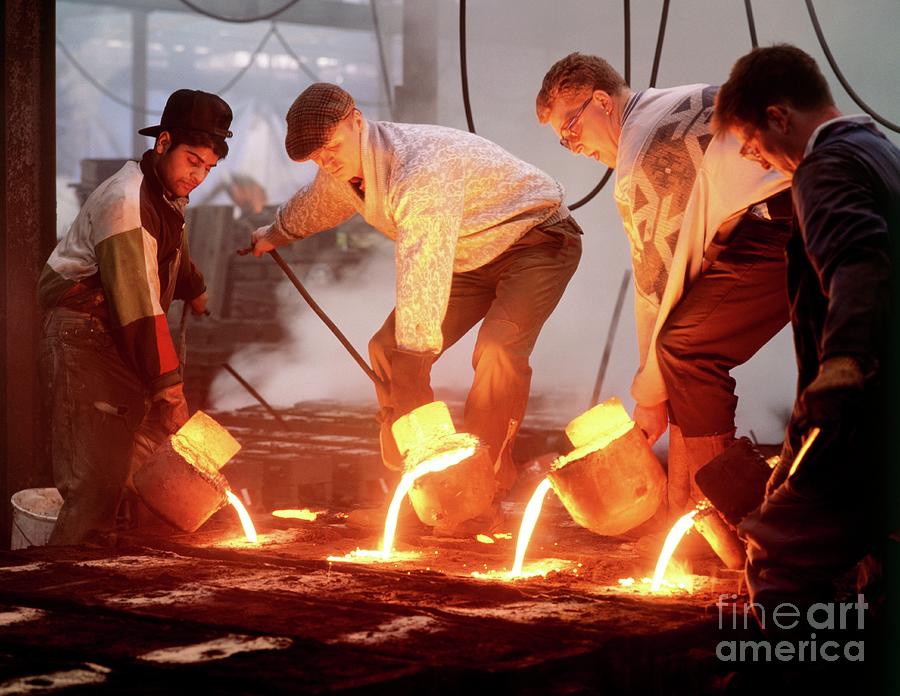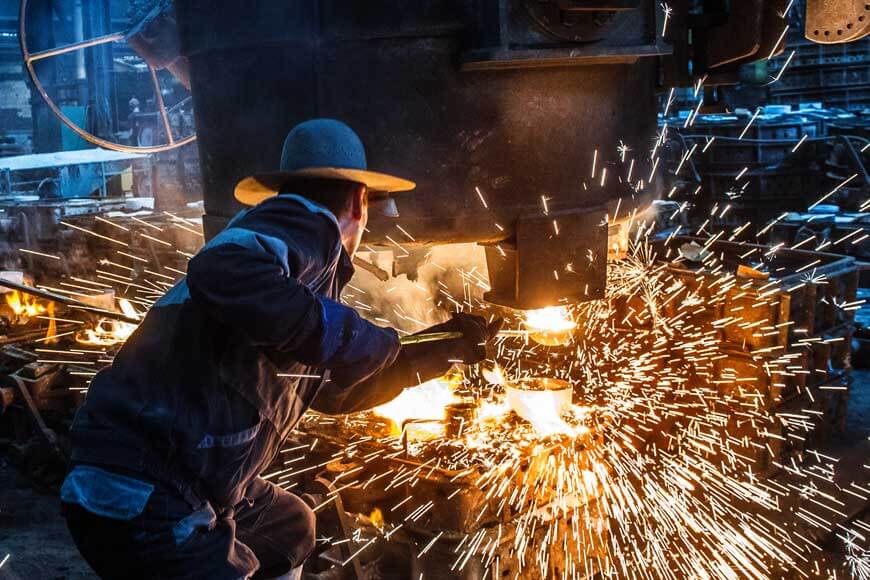Next generation of Metal Foundry production and innovation
Discover the Ingenious Techniques Made Use Of in a Metal Foundry for Superior Casting Results
In today's competitive manufacturing landscape, metal foundries are significantly embracing innovative strategies to improve spreading results - Aluminum Foundry. Advanced computer system simulations allow for precise modeling of molten metal behavior, while 3D printing makes it possible for quick production of intricate mold and mildews. Furthermore, eco-friendly products and automation enhance operations. These developments assure substantial improvements in performance and quality assurance. The influence of these innovations on sustainability and manufacturing techniques remains to be completely checked out.
Advanced Computer Simulations in Metal Casting
Advanced computer system simulations have actually changed the metal spreading process by enhancing precision and performance. These advanced devices enable designers to produce digital designs of cast parts, enabling them to forecast the behavior and assess of liquified metal throughout the casting phase. By simulating different specifications such as temperature, flow price, and air conditioning rates, suppliers can recognize possible defects before physical production starts.
This aggressive technique minimizes waste and lessens costly errors, eventually resulting in enhanced product top quality. In addition, simulations facilitate the optimization of mold designs, ensuring that they meet the certain requirements of each project. The assimilation of computational fluid characteristics (CFD) and limited aspect evaluation (FEA) more adds to the precision of these simulations, providing insights that were formerly unattainable. As an outcome, progressed computer simulations have come to be an indispensable element of contemporary metal foundries, considerably progressing the sector's capacities.
3D Printing for Mold And Mildews and Patterns
3D printing has become a groundbreaking strategy for developing molds and patterns in the metal foundry industry. This modern technology enables the fast production of complicated geometries that typical manufacturing methods battle to achieve. By making use of additive manufacturing, foundries can produce intricate designs with minimized preparations and product waste. The capability to create mold and mildews on need permits better adaptability in layout models, promoting faster prototyping and modifications.
Additionally, 3D printing can make use of a variety of materials, including plastics and metals, customized to specific casting needs. This adaptability enhances the accuracy of molds, resulting in exceptional casting results with enhanced surface finishes. Furthermore, the reduction in the number of parts needed streamlines assembly processes, further enhancing manufacturing performance. As foundries remain to take on 3D printing, they are poised to redefine industry standards, paving the way for development and boosted efficiency in metal spreading procedures.
Eco-Friendly Products and Processes
As the metal foundry market faces boosting pressure to lower its ecological impact, the fostering of environment-friendly products and processes has become important. Shops are now exploring lasting choices to standard materials, such as using recycled metals and bio-based binders. These materials not just decrease waste yet likewise lower power usage during manufacturing.
In addition, developments in sand spreading strategies have led to using artificial sands that are much less damaging to the environment. Shops are likewise executing innovative procedures like molten metal therapy that minimizes emissions and boosts the high quality of cast items.
Water-based finishes have actually replaced poisonous solvents, advertising a more secure work environment. By incorporating these environment-friendly methods, metal foundries can noticeably lower their environmental influence while preserving high-quality casting outcomes. This change not only benefits the atmosphere yet also aligns with the expanding customer demand for lasting production solutions
Automation and Robotics in Foundry Operations
While the metal foundry market welcomes advancement, the assimilation of automation and robotics is transforming operations considerably. Automated systems enhance processes such as mold making, metal pouring, and casting completing, click here for more substantially boosting efficiency. Robotics assist in the handling of hefty products, reducing the risk of work environment injuries and making certain safer environments.

Additionally, the use of automated More about the author guided automobiles (AGVs) enhances material transportation within facilities, guaranteeing prompt shipment of elements to appropriate workstations. By executing these technologies, foundries can adjust to changing demands with better dexterity, eventually resulting in improved profitability and competition in the market. As automation and robotics continue to develop, they hold the possible to redefine standard foundry practices and drive additional developments in casting strategies.
Real-Time Monitoring and High Quality Control Techniques
The developments in automation and robotics have actually led the means for extra innovative methods to quality control in metal foundries. Real-time monitoring systems make use of advanced sensors and information analytics to track crucial criteria throughout the casting procedure. These systems continuously examine variables such as product, pressure, and temperature level structure, enabling immediate detection of inconsistencies from developed standards.
Quality assurance strategies currently incorporate artificial intelligence algorithms that examine historic information to forecast potential problems before they happen. This proactive approach reduces waste and improves general manufacturing effectiveness. Furthermore, incorporated feedback loops allow for rapid adjustments, making sure that each spreading satisfies rigid high quality needs.
The execution of electronic doubles-- online replicas of physical assets-- has actually likewise reinvented high quality guarantee, permitting engineers to mimic and enhance processes blog here in real-time. With each other, these ingenious methods greatly enhance the reliability and high quality of castings, establishing brand-new sector criteria in metal foundry procedures.
Regularly Asked Questions
What Kinds of Metals Are Commonly Cast in Factories?
Generally cast steels in foundries include aluminum, brass, iron, and bronze. Each metal displays distinct residential or commercial properties, making them ideal for different applications, such as auto parts, equipment, and imaginative sculptures, enhancing their adaptability in manufacturing.

How much time Does the Casting Process Usually Take?
The spreading process commonly takes several hours to days, relying on factors such as the complexity of the mold and mildew, type of metal made use of, and cooling demands. Each stage affects the general period significantly.
What Precaution Remain In Location for Foundry Workers?

Exactly how Are Defects in Castings Identified and Addressed?
Issues in castings are identified through visual evaluations and non-destructive testing methods. Once detected, foundry employees resolve them by improving procedures, readjusting product structures, and executing restorative steps to guarantee top quality and conformity with criteria.
What Is the Expense Range for Metal Casting Services?
The price range for metal casting services typically ranges $1 to $10 per extra pound, depending upon elements such as product kind, intricacy of the design, and production volume, affecting total rates substantially.
In today's affordable production landscape, metal foundries are increasingly embracing ingenious strategies to enhance spreading results. As the metal foundry sector deals with increasing stress to reduce its environmental impact, the adoption of eco-friendly products and processes has actually become essential. Shops are now discovering sustainable choices to conventional products, such as using bio-based binders and recycled metals. By integrating these environment-friendly practices, metal foundries can markedly reduce their eco-friendly effect while preserving premium casting outcomes. The developments in automation and robotics have paved the means for extra sophisticated approaches to top quality guarantee in metal foundries.